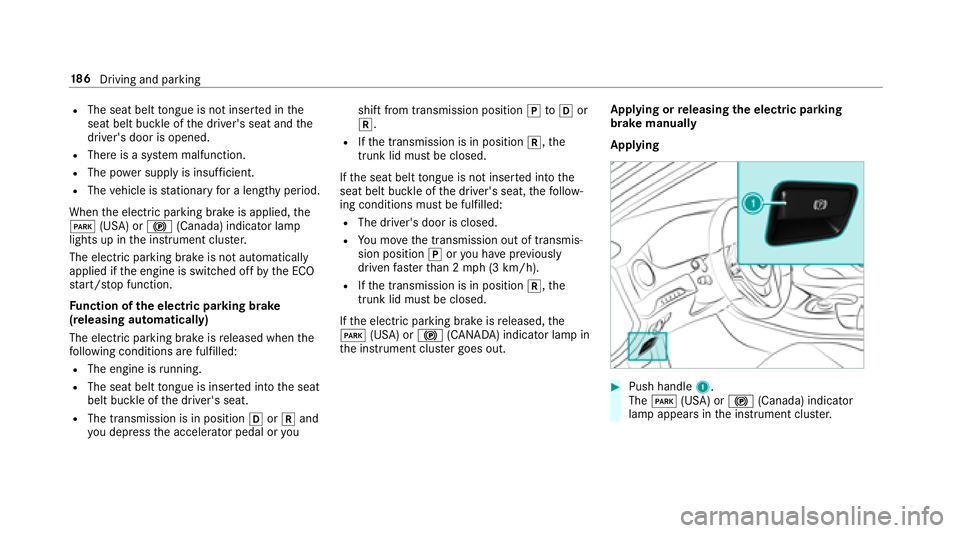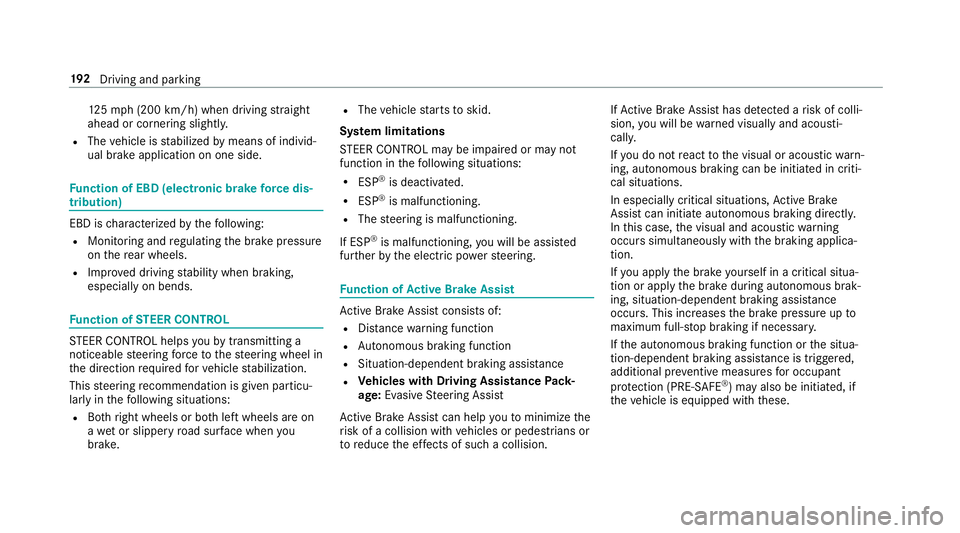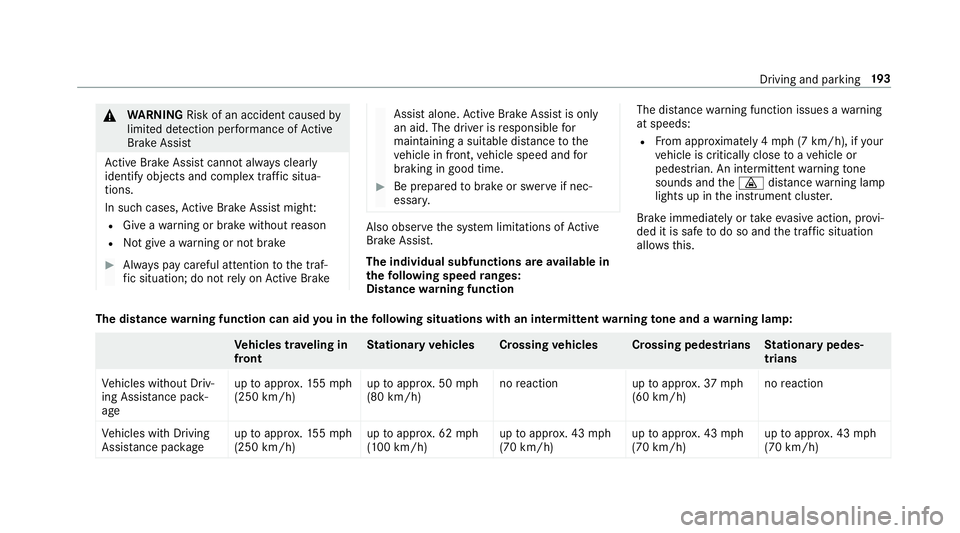2018 MERCEDES-BENZ S-CLASS SEDAN brake light
[x] Cancel search: brake lightPage 173 of 562

Plug-inhybrid: obser vethe no tes in the Supple‐
ment. Otherwise, you may not recognize dan‐
ge rs.
ECO start/s top function
Opera tion of the ECO start/s top function
Mercedes -AMG vehicles: be sure toobser ve
th e no tes in the Supplement. Otherwise, you
may not recognize dangers.
The engine is au tomatical lyswitched off if the
fo llowing conditions are me t:
RIfyo ubr ake theve hicle toast andstill in
transmission position hori.
RIf all vehicle conditions for an au tomatic
engine stop are met.
The è symbol appears in the multifunction
display when theve hicle is stationar y.
The engine is restar ted automatically if:
RYo ure lease the brake pedal with the trans‐
mission in position hwhen the HOLD func‐
tion is not active.
RYo u shift from transmission position j.
RYou enga getransmission position hork.
RYou depress the accelerator pedal.
RYo uch ange theve hicle le vel.
RAn automatic engine start is necessar y.
If th e engine was switched off bythe ECO start/
st op function and you lea vetheve hicle, a warn‐
ing tone sounds. The �9�H�K�L�F�O�H �2�S�H�U�D�W�L�R�Q�D�O �6�Z�L�W�F�K
�W�K�H �,�J�Q�L�W�L�R�Q �2�I�I �%�H�I�R�U�H �(�[�L�W�L�Q�J displaymessage
also appears in the multifunction displa y.Ifyo u
do not switch off the ignition, the ignition is
automatically switched off af ter one minute. Deactivating or activating
the ECO start/
sto p function
#Press button 1.
If indicator la mp2lights up, the ECO start/
st op function is switched on.
Driving and parking 17
1
Page 188 of 562

RThe seat belttongue is not inser ted in the
seat belt buckle of the driver's seat and the
driver's door is opened.
RThere is a sy stem malfunction.
RThe po wer supp lyis insuf ficient.
RThe vehicle is stationary for a lengt hyperiod.
When the electric parking brake is applied, the
F (USA) or !(Canada) indicator lamp
lights up in the instrument clus ter.
The electric parking brake is not automatically
applied if the engine is switched off bythe ECO
st art/ stop function.
Fu nction of the electric pa rking brake
(releasing automatically)
The elect ric park ing brake is released when the
fo llowing conditions are fulfilled:
RThe engine is running.
RThe seat belt tongue is inser ted into the seat
belt buckle of the driver's seat.
RThe transmission is in position hork and
yo udepr essthe accelera tor pedal or you shift from transmission position
jtoh or
k.
RIf th e transmission is in position k,the
trunk lid must be closed.
If th e seat belt tongue is not inser ted into the
seat belt buckle of the driver's seat, thefo llow‐
ing conditions must be fulfilled:
RThe driver's door is closed.
RYo u mo vethe transmission out of transmis‐
sion position joryou ha veprev iously
driven fasterthan 2 mph (3 km/h).
RIfth e transmission is in position k,the
trunk lid must be closed.
If th e elect
ric parking brake is released, the
F (USA) or !(CANADA) indicator lamp in
th e instrument clus ter goes out. Applying or
releasing the electric pa rking
brake manually
Applying
#Push handle 1.
The F (USA) or !(Canada) indicator
lamp appears in the instrument clus ter.
18 6
Driving and pa rking
Page 191 of 562

Functions of ABS (anti-lock braking sy stem)
ABS regulates the brake pressure in critical driv‐
ing situations:
RDuring braking, e.g. at maximum full-s top
braking or insuf ficient traction of the tires,
th e wheels are pr evented from blocking.
RVe hicle steerability while braking is ensured.
If ABS inter venes when braking, youwill feel a
pulsing in the brake pedal. The pulsating brake
pedal can be an indication of hazardous road
conditions and can ser veas a reminder totake
ex tra care while driving.
Sy stem limitations
RABS is active from speeds of appr ox. 5 mph
(8 km/h).
RABS may be impaired or may not function if a
malfunction has occur red and theye l‐
low ! ABSwarning lamp lights up contin‐
uously in the instrument clus ter af terth e
engine is star ted.
Fu nction of BAS (Brake Assist Sy stem)
&
WARNING Risk of an accident caused by
a malfunction in BAS (Brake Assist Sys‐
te m)
If BA S is malfunctioning, the braking dis tance
in an emergency braking situation is
increased.
#Depre ssthe brake pedal with full forc e
in emer gency braking situations. ABS
pr eve nts the wheels from locking.
BA S suppo rts yo ur eme rgency braking situation
with additional brake forc e.
If yo u depress the brake pedal quickl y,BA S is
acti vated:
RBA S au tomatical lyboosts the brake pres‐
sure.
RBA S can short enthe braking dis tance.
RABS pr events the wheels from locking.
The brakes will function as usual once you
re lease the brake pedal. BAS is deactivated.
Functions of ESP®(Electronic Stability Pro‐
gr am)
&
WARNING Risk of skidding if ESP®is
malfunctioning
If ESP
®is malfunctioning, ESP®cannot car ry
out vehicle stabilization. In addition, other
driving saf etysy stems are switched off.
#Drive on carefull y.
#Have ESP®checked at a qualified spe‐
cialist workshop.
&
WARNING Risk of skidding if ESP®is
deactivated
If yo u deactivate ESP
®, ESP®cannot car ry
out vehicle stabilization.
#ESP®should only be deactivated in the
fo llowing situations.
Mercedes‑AMG vehicles: observeth e no tes in
th e Supplement. Otherwise, you may not recog‐
nize dangers.
Driving and park ing18
9
Page 192 of 562

ESP®can monitor and impr ovedriving stability
and traction in thefo llowing situations, within
ph ysical limits:
RWhen pulling away on a wet or slippe ryroad.
RWhen braking.
RIn stro ng sidewinds when you are driving
fast erthan 50 mph (80 km/h).
If th eve hicle deviates from the direction desired
by the driver, ESP
®can stabilize theve hicle by
inter vening in thefo llowing ways:
ROne or more wheels are braked.
RThe engine output is adap ted according to
th e situation.
ESP
®is deactivated if the ESP®OFF å warn‐
ing lamp lights up continuously in the instrument
clus ter:
RDriving stability will no longe r be improved.
RCrosswind Assist is no longer active.
RThe drive wheels could spin.
RETS/4ETS traction control is still active.
% When ESP
®is deactivated, you are still assis‐
te dby ESP®when braking.
ESP
®is inter vening if the ESP®÷ warning
lamp flashes in the instrument clus ter:
RDo not deacti vate ESP®.
ROnly depress the accelera tor pedal as far as
is necessar y.
RAdapt your drivin gst yle to suit the cur rent
ro ad and weather conditions.
Deactivate ESP
®in thefo llowing situations to
impr ovetraction:
RWhen using snow chains
RIn deep snow
ROn sand or gr avel.
% Spinning the wheels results in a cutting
action which pr ovides better grip.
If th e ESP
®÷ warning lamp lights up continu‐
ousl y,ESP®is not available due toa malfunction. Observ
eth efo llowing information:
RWa rning and indicator lamps (→page 501)
RDisplay messages (→page 457)
ETS/4ETS (Electronic Traction Sy stem)
ETS/4ETS traction control is pa rtof ESP
®and
makes it possible topull away or accelerate on a
slippery sur face.
ETS/4ETS can impr oveth eve hicle's traction by
inter vening in thefo llowing ways:
RThe drive wheels are braked individually if
they spin.
RMore drive torque is transferred tothe wheel
or wheels with traction.
Influence of drive prog rams on ESP
®
The drive programs enable ESP®to adapt todif‐
fe re nt we ather and road conditions as well as
th e driver's prefer red driving style. You can
select the drive programs using theDY NA MIC
SELECT switch (
→page 173).
19 0
Driving and pa rking
Page 194 of 562

125mp h(2 00 km/h) when driving stra ight
ahead or cornering slightly.
RThe vehicle is stabilized bymeans of individ‐
ual brake application on one side.
Fu nction of EBD (electronic brake forc e dis‐
tribution)
EBD is characterized bythefo llowing:
RMonitoring and regulating the brake pressure
on there ar wheels.
RImpr oved driving stability when braking,
especially on bends.
Fu nction of STEER CONT ROL
STEER CONTROL helps youby transmitting a
noticeable steering forc eto thesteering wheel in
th e direction requiredforve hicle stabilization.
This steering recommendation is given part icu‐
lar lyin thefo llowing situations:
RBo th right wheels or bo thleft wheels are on
a we t or slippe ryroad sur face when you
brake.
RThe vehicle starts toskid.
Sy stem limitations
ST EER CONTROL may be impaired or may not
function in thefo llowing situations:
RESP®is deactivated.
RESP®is malfunctioning.
RThe steering is malfunctioning.
If ESP
®is malfunctioning, youwill be assis ted
fur ther by the electric po werst eering.
Fu nction of Active Brake Assi st
Active Brake Assi stconsist s of:
RDistance warning function
RAu tonomous braking function
RSituation-dependent braking assist ance
RVehicles with Driving Assistance Pack‐
age: Evasi veSteering Assist
Ac tive Brake Assi stcan help youto minimize the
ri sk of a collision with vehicles or pedestrians or
to reduce the ef fects of such a collision. If
Ac tive Brake Assi sthas de tected a risk of colli‐
sion, you will be warned visually and acousti‐
cally.
If yo udo not react tothe visual or acoustic warn‐
ing, autonomous braking can be initiated in criti‐
cal situations.
In especially critical situations, Active Brake
Assi stcan initiate autonomous braking direct ly.
In this case, the visual and acoustic warning
occurs simultaneously with the braking applica‐
tion.
If yo uappl yth e brake yourself in a critical situa‐
tion or applyth e brake during autonomous brak‐
ing, situation-dependent braking assis tance
occurs . This increases the brake pressure up to
maximum full-s top braking if necessar y.
If th e autonomous braking function or the situa‐
tion-dependent braking assis tance is trig gered,
additional pr eventive measures for occupant
pr otection (PRE-SAFE®) may also be initiated, if
th eve hicle is equipped with these.
19 2
Driving and pa rking
Page 195 of 562

&WARNING Risk of an accident caused by
limited de tection per form ance of Active
Brake Assi st
Ac tive Brake Assi stcannot al ways clear ly
identify objects and complex traf fic situa‐
tions.
In such cases,Active Brake Assi stmight:
RGive a warning or brake without reason
RNo t give a warning or not brake
#Alw ays pay careful attention tothe traf‐
fi c situation; do not rely on Active Brake
Assi stalone. Active Brake Assi stis only
an aid. The driver is responsible for
maintaining a sui table dis tance tothe
ve hicle in front, vehicle speed and for
braking in good time.
#Be prepared tobrake or swer veif nec‐
essar y.
Also obser vethe sy stem limitations of Active
Brake Assi st.
The individual subfunctions are available in
th efo llowing speed ranges:
Distance warning function The dis
tance warning function issues a warning
at speeds:
RFr om appr oximately 4 mph (7 km/h), if your
ve hicle is critically close toave hicle or
pedestrian. An intermittent warning tone
sounds and the· distance warning lamp
lights up in the instrument clus ter.
Brake immediately or take evasive action, pr ovi‐
ded it is safe todo so and the traf fic situation
allo wsthis.
The distance warning function can aid you in thefo llowing situations with an intermit tent wa rning tone and a warning lamp:
Ve hicles tr aveling in
front St
ationary vehicles Crossing vehicles Crossing pedestrians Stationary pedes‐
trians
Ve hicles without Driv‐
ing Assis tance pa ck‐
age up
toappr ox.15 5mp h
(250 km/h) up
toappr ox. 50 mph
(80 km/h) no
reaction uptoappr ox.37 mph
(60 km/h) no
reaction
Ve hicles with Driving
Assis tance pa ckage up
toappr ox.15 5mp h
(250 km/h) up
toappr ox. 62 mph
(100 km/h) up
toappr ox. 43 mph
(70 km/h) up
toappr ox. 43 mph
(70 km/h) up
toappr ox. 43 mph
(70 km/h)
Driving and parking 19
3
Page 197 of 562

Canceling a brake application ofActive Brake
Assi st
Yo u can cancel a brake applic ation of Active
Brake Assi stat any time by:
RDep ressing the accelera tor pedal fully.
RRe leasing the brake pedal.
Ac tive Brake Assi stcancels the inter vention
when at least one of thefo llowing conditions is
fulfilled:
RYo u maneuver to avoidthe obs tacle.
RThere is no longer a risk of collision.
RAn obs tacle is no longer de tected in front of
yo ur vehicle.
Evasive Steering Assist (only vehicles with
Driving Assistance pac kage)
Evasive Steering Assist has thefo llowing charac‐
te rist ics:
RCan de tect stationary or crossing pedes‐
trians.
RCan assist the driver with additional steering
assis tance if it de tects a swerving maneuver.
RCan be acti vatedby an abrupt steering mo ve‐
ment during a swerving maneu ver.
RCan assist during swerving and stra ightening
of theve hicle.
RCan react from a speed of appr oximately
12 mp h(2 0 km/h) up toa speed of appr ox‐
imately 43 mph(7 0 km/h).
RYo u can preve ntthe assis tance at any time
by active steering.
&
WARNING Risk of an accident despite
Evasive Steering Assist
Evasive Steering Assist cannot always clearly
identify objects and complex traf fic situa‐
tions.
In addition, thesteering support of Evasive
St eering Assist is generally not suff icientto
av oid a collision.
In such cases Evasive Steering Assist can:
Rgive an unnecessary warning or pr ovide
assis tance
Rnot give awa rning or not pr ovide assis‐
ta nce
#Alw ays pay careful attention tothe traf‐
fi c situation; do not rely on Ev asive
St eering Assist alone.
#Be ready tobrake and take evasive
action if necessar y.
#Preve ntthe assis tance byactively steer‐
ing in non-critical driving situations.
#Drive at an appropriate speed if pedes‐
trians are close tothe path of your vehi‐
cle.
Also obser vethe sy stem limitations of Evasive
St eering Assist.
Sy stem limitations
The sy stem may be impaired or may not function
in thefo llowing situations:
RIn sno w,rain, fog, heavy spr ay, if there is
gl are, in direct sunlight or in greatlyvarying
ambient light.
RIf th e sensors are dirty, fogged up, damaged
or co vered.
Driving and parking 19
5
Page 199 of 562

Cruise cont rol is operated using the cor respond‐
ing steering wheel buttons. You can store any
ro ad speed abo ve15 mp h (20 km/h).
If yo ufa ilto adapt your drivin gst yle, cruise con‐
trol can neither reduce therisk of an accident
nor override the la wsof ph ysics. It cannot take
into account road, weather or traf fic conditions.
Cruise control is only an aid. You are responsible
fo rth e dis tance totheve hicle in front, forve hi‐
cle speed, for braking in good time and forst ay ‐
ing in lane.
Displa ysinthe multifunction display
The status of cruise control and thestored
speed are shown in the multifunction displa y.
1Cruise control is selecte d
2Speed is sa ved, cruise control is deactivated
3Speed is sa ved, cruise control is activated
% The segments between thestored speed and
th e end of the segment display light up in
th e speedome ter.
Sy stem limitations
Cruise control may be unable tomaintain the
st ored speed on uphill gradients. The stored
speed is resumed when the gradient evens out.
Change into a lo werge ar in good time on long
and steep downhill gradients. Take particular
no te ofthis when driving a laden vehicle. By doing so,
youwill make use of the braking ef fect
of the engine. This relie vesth e load on the brake
sy stem and pr events the brakes from overheat‐
ing and wearing tooqu ickl y.
Do not use cruise control in thefo llowing situa‐
tions:
RIn traf fic situations whi chrequ ire frequent
ch anges of speed, e.g. in heavy traf fic, on
winding roads
ROn slippery roads. Accelerating can cause
th e drive wheels tolose traction and the
ve hicle could then skid
RWhen visibility is poor
Operating cruise control
& WARNING Risk of accident due tostored
speed
If yo u call up thestored speed and this is
lo we rth an your cur rent speed, theve hicle
decelerates.
#Ta ke into account the tra ffic situation
before calling up thestored speed.
Driving and parking 19
7